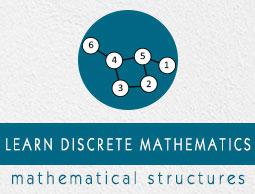Discrete Mathematics - Rules of Inference
To deduce new statements from the statements whose truth that we already know, Rules of Inference are used.
What are Rules of Inference for?
Mathematical logic is often used for logical proofs. Proofs are valid arguments that determine the truth values of mathematical statements.
An argument is a sequence of statements. The last statement is the conclusion and all its preceding statements are called premises (or hypothesis). The symbol “$\therefore$”, (read therefore) is placed before the conclusion. A valid argument is one where the conclusion follows from the truth values of the premises.
Rules of Inference provide the templates or guidelines for constructing valid arguments from the statements that we already have.
Table of Rules of Inference
| Rule of Inference |
Name |
Rule of Inference |
Name |
$$\begin{matrix}
P \\
\hline
\therefore P \lor Q
\end{matrix}$$ |
Addition |
$$\begin{matrix}
P \lor Q \\
\lnot P \\
\hline
\therefore Q
\end{matrix}$$ |
Disjunctive Syllogism |
$$\begin{matrix}
P \\
Q \\
\hline
\therefore P \land Q
\end{matrix}$$ |
Conjunction |
$$\begin{matrix}
P \rightarrow Q \\
Q \rightarrow R \\
\hline
\therefore P \rightarrow R
\end{matrix}$$ |
Hypothetical Syllogism |
$$\begin{matrix}
P \land Q\\
\hline
\therefore P
\end{matrix}$$ |
Simplification |
$$\begin{matrix}
( P \rightarrow Q ) \land (R \rightarrow S) \\
P \lor R \\
\hline
\therefore Q \lor S
\end{matrix}$$ |
Constructive Dilemma |
$$\begin{matrix}
P \rightarrow Q \\
P \\
\hline
\therefore Q
\end{matrix}$$ |
Modus Ponens |
$$\begin{matrix}
(P \rightarrow Q) \land (R \rightarrow S) \\
\lnot Q \lor \lnot S \\
\hline
\therefore \lnot P \lor \lnot R
\end{matrix}$$ |
Destructive Dilemma |
$$\begin{matrix}
P \rightarrow Q \\
\lnot Q \\
\hline
\therefore \lnot P
\end{matrix}$$ |
Modus Tollens |
|
|
Addition
If P is a premise, we can use Addition rule to derive $ P \lor Q $.
$$\begin{matrix}
P \\
\hline
\therefore P \lor Q
\end{matrix}$$
Example
Let P be the proposition, “He studies very hard” is true
Therefore − "Either he studies very hard Or he is a very bad student." Here Q is the proposition “he is a very bad student”.
Conjunction
If P and Q are two premises, we can use Conjunction rule to derive $ P \land Q $.
$$\begin{matrix}
P \\
Q \\
\hline
\therefore P \land Q
\end{matrix}$$
Example
Let P − “He studies very hard”
Let Q − “He is the best boy in the class”
Therefore − "He studies very hard and he is the best boy in the class"
Simplification
If $P \land Q$ is a premise, we can use Simplification rule to derive P.
$$\begin{matrix}
P \land Q\\
\hline
\therefore P
\end{matrix}$$
Example
"He studies very hard and he is the best boy in the class", $P \land Q$
Therefore − "He studies very hard"
Modus Ponens
If P and $P \rightarrow Q$ are two premises, we can use Modus Ponens to derive Q.
$$\begin{matrix}
P \rightarrow Q \\
P \\
\hline
\therefore Q
\end{matrix}$$
Example
"If you have a password, then you can log on to facebook", $P \rightarrow Q$
"You have a password", P
Therefore − "You can log on to facebook"
Modus Tollens
If $P \rightarrow Q$ and $\lnot Q$ are two premises, we can use Modus Tollens to derive $\lnot P$.
$$\begin{matrix}
P \rightarrow Q \\
\lnot Q \\
\hline
\therefore \lnot P
\end{matrix}$$
Example
"If you have a password, then you can log on to facebook", $P \rightarrow Q$
"You cannot log on to facebook", $\lnot Q$
Therefore − "You do not have a password "
Disjunctive Syllogism
If $\lnot P$ and $P \lor Q$ are two premises, we can use Disjunctive Syllogism to derive Q.
$$\begin{matrix}
\lnot P \\
P \lor Q \\
\hline
\therefore Q
\end{matrix}$$
Example
"The ice cream is not vanilla flavored", $\lnot P$
"The ice cream is either vanilla flavored or chocolate flavored", $P \lor Q$
Therefore − "The ice cream is chocolate flavored”
Hypothetical Syllogism
If $P \rightarrow Q$ and $Q \rightarrow R$ are two premises, we can use Hypothetical Syllogism to derive $P \rightarrow R$
$$\begin{matrix}
P \rightarrow Q \\
Q \rightarrow R \\
\hline
\therefore P \rightarrow R
\end{matrix}$$
Example
"If it rains, I shall not go to school”, $P \rightarrow Q$
"If I don't go to school, I won't need to do homework", $Q \rightarrow R$
Therefore − "If it rains, I won't need to do homework"
Constructive Dilemma
If $( P \rightarrow Q ) \land (R \rightarrow S)$ and $P \lor R$ are two premises, we can use constructive dilemma to derive $Q \lor S$.
$$\begin{matrix}
( P \rightarrow Q ) \land (R \rightarrow S) \\
P \lor R \\
\hline
\therefore Q \lor S
\end{matrix}$$
Example
“If it rains, I will take a leave”, $( P \rightarrow Q )$
“If it is hot outside, I will go for a shower”, $(R \rightarrow S)$
“Either it will rain or it is hot outside”, $P \lor R$
Therefore − "I will take a leave or I will go for a shower"
Destructive Dilemma
If $(P \rightarrow Q) \land (R \rightarrow S)$ and $ \lnot Q \lor \lnot S $ are two premises, we can use destructive dilemma to derive $\lnot P \lor \lnot R$.
$$\begin{matrix}
(P \rightarrow Q) \land (R \rightarrow S) \\
\lnot Q \lor \lnot S \\
\hline
\therefore \lnot P \lor \lnot R
\end{matrix}$$
Example
“If it rains, I will take a leave”, $(P \rightarrow Q )$
“If it is hot outside, I will go for a shower”, $(R \rightarrow S)$
“Either I will not take a leave or I will not go for a shower”, $\lnot Q \lor \lnot S$
Therefore − "Either it does not rain or it is not hot outside"


